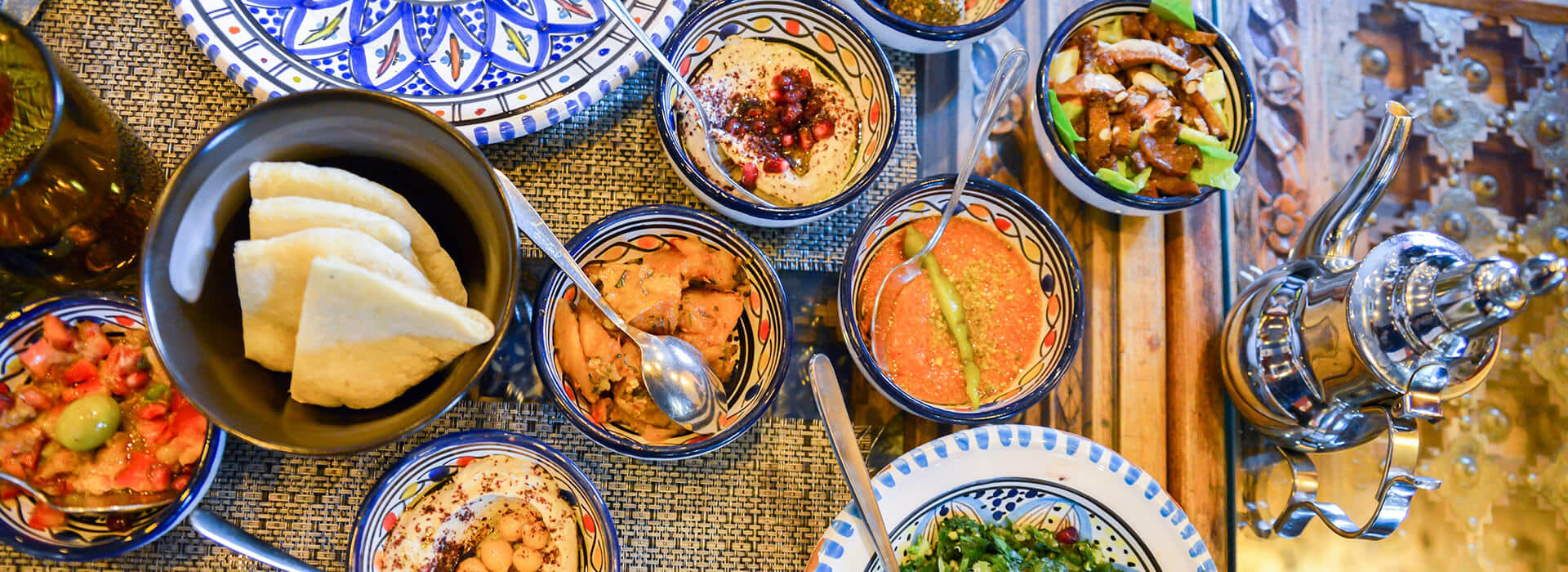Top 10 Jordanian Dishes You Need to Try
Food is the best way to learn about a country and a culture. It is not only a culinary delight, but it binds societies and cultures together. Food is such an integral part of Jordanian culture, and when you start eating, you’re almost certain to meet and mingle with some of the most hospitable and friendly people you’ve ever met.
Jordanian cuisine is a part of Levantine cuisine and shares many traits and similarities with the cuisine of Lebanon, Palestine and Syria, often with some local variations. More generally Jordanian cuisine is influenced by historical connections to the cuisine of Turkey and the former Ottoman Empire. Jordanian cuisine is also influenced by the cuisines of groups who have made a home for themselves in modern Jordan, including Armenians, Circassians, Iraqis, Palestinians, and Syrians. Food is a very important aspect of life of Jordanian people. In villages, meals are a community event with immediate and extended family present.
In addition, food is commonly used by Jordanians to express their hospitality and generosity. Jordanians serve family, friends, and guests with great pride in their homes, no matter how modest their means. Here we listed the top 10 Jordanian dishes you should try when you travel to Jordan next time.
#1. Mansaf
Mansaf is the national dish of Jordan that plays a key role in all celebrations and festivals in the country. The meat is slowly cooked in fermented, yogurt-like goat's milk called jameed, resulting in a unique dish that is not just a meal, but a social tradition. Jameed is how Bedouins preserve the milk from their goats. To make it, the yogurt is drained in cotton sacks to remove the whey and salted every day until it thickens.
Mansaf, an Arabic word for explosion, is commonly offered to guests as a sign of appreciation, value, and respect. It can be made with goat, beef, or chicken meat, where goat signifies the highest level of respect and value, and chicken the least, so beef or chicken is rarely to be seen in Mansaf. There are three main components to mansaf: rice, lamb, and jameed. The jameed, which is a hard dried out and fermented goat milk yoghurt, is re-hydrated into a gravy, and used to pour over the rice and lamb. The rice and lamb are fantastic, but mansaf really shines because of the jameed, which has a sour and salty taste, and an undeniable goat flavor. When you eat a ball of mansaf, you can literally taste the land of Jordan in your bite – it’s amazing.
#2. Warak Enab(Stuffed Grape Leaves)
“Warak” means paper, and “Enab” means grapes. Warak enab is a traditional Jordanian dish consisting of stuffed grape leaves that are simmered in a lemon-flavored broth. The ingredients include grape leaves, ground beef, rice, allspice, cinnamon, salt, lemon juice, oil, and lamb chops or ribs for the broth. Once cooked, these stuffed rolls are usually garnished with a few lemon slices on top or, alternatively, olives and tomato slices. You can make this dish vegan-friendly by removing the ground meat.
#3. Maqluba
Literally translated at upside down, maqluba includes rice, vegetables (often carrots, potatoes, tomatoes, cauliflower, onions), herbs and spices (often turmeric and sumac), and meat such as chicken or lamb. Once the dish is ready, the pot is flipped over onto a big plate or communal tray, so the rice stays on the bottom, and the meat or chicken is left on the top. Maqluba can be garnished with parsley, fried pine nuts or other types of nuts, and slices of lemon. The rice, since it’s cooked with meat or chicken, takes on a lovely broth flavor kind of like chicken rice (if you eat chicken maqluba), and the meat or chicken becomes fall apart tender from the long cooking process. It is usually eaten with just a side of yoghurt and green salad. It is such a flavorsome dish that you don’t really need anything else.
#4. Mulukhiyah (or Molokhia)
Mulukhiyah, also known as mulukhiya, mulukhia, or molokhia, is a classic Middle Eastern dish, a delicious soupy vegetable dish made with Jew’s Mallow, a distinctive tasting leafy green. It’s cooked with chicken broth, and is utterly comforting. Traditionally, the soup is cooked with garlic, coriander, chicken meat or chicken stock, and is usually served with white rice or pita bread, and a lemon or lime wedge on the side.
It is believed that the dish dates back to the time of the Pharaohs in Egypt, its name coming from the word mulokia, meaning Kingdom of Royals, referring to the fact that it was consumed only by the kings, queens, and nobles during the era. Its slimy texture and strong aromas have caught the hearts of many people, so the soup is also quite popular in Jordan, Lebanon, Palestine, and throughout the Middle East.
#5. Mujadara (Lentils and Rice with Caramelized Onions)
A typical everyday Jordanian food is Mujadara, a mixture of rice, lentils, and a seasoning that includes cumin. It’s something that nearly everyone knows the recipe for how to cook it at home, and it’s commonly eaten as a dish that’s quick and easy. It’s also a favorite main dish for vegetarians in Jordan as well.
#6. Musakhan
Musakhan is a Jordanian dish of slices of bread, chicken, heaps of onions, fragrant spices like allspice and cinnamon, and lots of olive oil. The chicken is roasted and then baked together with a variety of spices including sumac and saffron which are regional spices and worth tasting while in Jordan. The dish is also comprised of onions and pine nuts which are toasted or fried and the entire mixture is served over bread which is baked in a clay oven.
#7. Shorabet Adas (Middle Eastern Lentil Soup)
Shorbat Adas is an Jordanian lentil soup made with a mix of red lentils, vegetables, spices, and stock. Shorabet adas is made all over the Middle East with different regions using a variation of spices. The Jordanian style shorabet adas is flavored with garlic, onion, cumin, coriander, turmeric, and chili powder. Often served as an entrée during the Holy Month of Ramadan, or in chilly winter months, this soup can also be served in the summer with delicious homemade “Kibbeh” (minced meat and bulgur shells stuffed with a filling of gently fried meat, onions and pine nuts), and a side dish of “Mutabbal.”
#8. Kobbeh(Meat ball)
Kobbeh, a form of the Arabic word kubbah or "ball," is a staple in Middle Eastern cuisine. Made out of lamb or beef, these lemon-shaped croquettes are a flavorful blend of fragrant herbs and spices, filling meat, and hearty bulgur wheat. Delicious as an appetizer or side dish, the hearty zeppelins are wonderful when served with hummus, khyar bi laban (a yogurt-cucumber salad), pita bread, and labneh (strained yogurt).
#9. Makmoura (Spiced Chicken and Onion Pie)
Makmoura is one of the most famous and popular Jordanian dishes, which is often served in occasions and festivals, because it adds a beautiful look to the table. Although it needs some time and effort, but its taste is worth it.
A dish that rewards patience, makmoura translates as ‘buried’ and is prepared by alternating layers of dough with lamb or chicken, onions and an array of seeds and beloved regional spices such as sumac and cumin. Originating from the north of the country, it makes liberal use of the olive oil harvested from that region and can take as long as four hours to cook, after which it is sliced and served in cake-like wedges with its contents spilling out onto the plate alongside servings of rice and cabbage.
#10. Rashouf
Rashouf is a traditional Jordanian soup that is typically made with a combination of green lentils, fried onions, jameed (dried goat's or ewe’s milk yogurt), yogurt, water, and chicken stock. Bulgur wheat, crushed wheat, or groats are often added to the combination, and the soup is usually enjoyed warm with additional fried onions sprinkled on top and a drizzle of mint sauce around the center. A common winter staple, this hearty soup is generally accompanied by sour pickles and vegetables on the side. Rashouf is typically associated with the cuisine of Northern Jordan, especially with the cities located at higher altitudes, such as Salt. This soup is often served alongside mansaf, Jordan's national dish, which also contains jameed.



